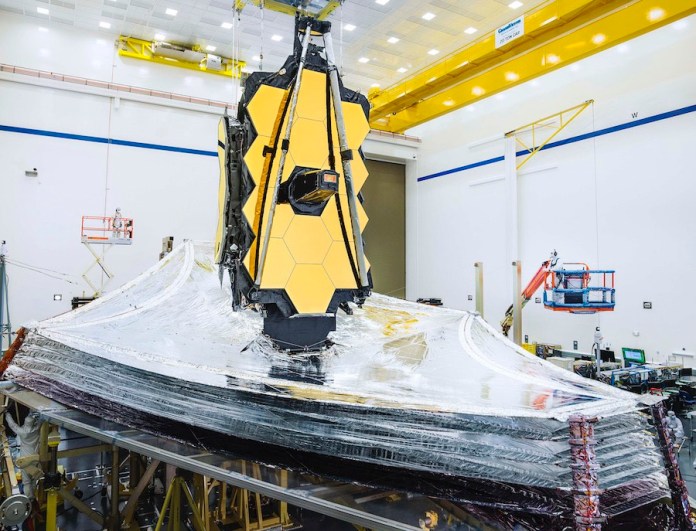Technicians inspect a part of the James Webb Space Telescope after extending it at the identical maneuver known it will perform in in space. Credit: Northrop GrummanThe launch of the James Webb Space Telescope won’t occur in March 2021 — the mission launch date — after the coronavirus pandemic forced a more than 50 percent reduction in staff levels at the observatory’s assembly and test facility.
The James Webb Space Telescope is the largest space science observatory ever built. The spacecraft and telescope are totally assembled inside a Northrop Grumman facility in Redondo Beach, California, before JWST is ready for shipment for its launch base in Kourou, French 38, however evaluation landmarks remain.
Because the COVID-19 pandemic started impacting work programs testing of the James Webb Space Telescope has continued at a reduced pace.
“Not everyone was accessible. There were positive cases here and there…Hopefully, we won’t start in March, absolutely won’t start in March,” explained Thomas Zurbuchen, associate manager of NASA’s science mission directorate. “This is not in the cards at the moment. It is not because they did something wrong. It is simply not likely to be in the cards. It is not a mistake, or even any mismanagement of some type.”
Zurbuchen added he is”very optimistic” the observatory can still start in 2021.
“There still is a good deal of mountain to climb,” he explained.
Oversight managers based at the Goddard Space Flight Center and NASA engineers in Maryland, in which the JWST project is managed, left the Northrop Grumman facility in March in California. That ceased functioning on product programs and JWST’s optical telescope, which is the responsibility of NASA.
Northrop Grumman, the prime contractor for sunshield along with the JWST spacecraft, was able to continue some work. But the progress has been slower than intended.
“Northrop Grumman went from two shifts, six days per week, to a single shift, five days per week, thus operating at roughly 40% efficacy. So a big impact to James Webb Space Telescope,” stated Steve Jurczyk, NASA’s associate manager, at a June 9 demonstration during a joint meeting of the National Academies’ Aeronautics and Space Engineering Board and the Space Studies Board.
In May, Northrop Grumman was able to check the extension of the Deployable Tower Assembly, that will produce a gap between the telescope and instrument compartment along with the spacecraft bus of JWST of the observatory. The extension of the tower assembly will enable the telescope and tools, which are folded up to match inside the fairing of JWST’s Ariane 5 rocket, also to be deciphered in space and cooled to temperature.
“The NASA/Northrop Grumman team resumed near-full operations”
Artist’s concept of the James Webb Space Telescope set up after launch. Credit: ESA, NASA, S. Beckwith (STScI) and the HUDF Team, Northrop Grumman Aerospace Systems / / STScI / / ATG medialabWith NASA workers now back on-site at Northrop Grumman’s test center in Southern California,” Zurbuchen said that teams will need to”know the new efficacy” as technicians get used to functioning together with bodily distancing and other constraints to decrease the probability of coronavirus transmission.
“We are not through (using all the coronavirus) at the point,” Zurbuchen stated. “We will still have consequences.”
JWST was scheduled for launch on an Ariane 5 rocket from French Guiana on March 30, 2021. The Ariane 5 launch a part of the European Space Agency’s contribution to the app.
Zurbuchen stated NASA will convene a schedule inspection from July to evaluate the impacts before setting a new launch date.
The assignment is currently working years behind schedule, and it’s projected to cost billions of dollars more than NASA initially envisioned. JWST’s total cost to NASA was recently projected to be $9.66 billion, and that amount does not include donations from ESA and the Canadian Space Agency.
Teams working in the spacecraft factory in Southern California of Northrop Grumman joined the science fiction and spacecraft modules of JWST last August, forming the observatory that was complete for the first time. Engineers at Northrop Grumman — NASA’s prime contractor for the observatory — intended to put the craft through a collection of electric, setup, vibration, and tests to make sure it will work as designed after launch with JWST assembled.
The mirror and also the thermal sunshield of JWST will fold origami-style upward to match inside the nose shroud of its Ariane 5 launcher.
Scientists say the James Webb Space Telescope’s four infrared engineering tools — that come in U.S., European and Canadian associations — will observe the very earliest stars and galaxies in the universe, observing light introduced some 13.5 billion years ago. Using imaging power 100 times gather information on the chemical and physical properties of planets around other stars and before the Hubble Space Telescope, JWST may peer to nebulas.
– Advertisement –
